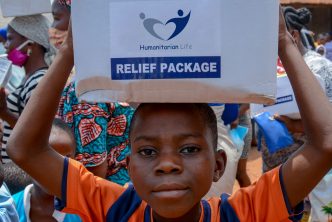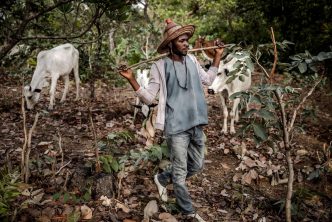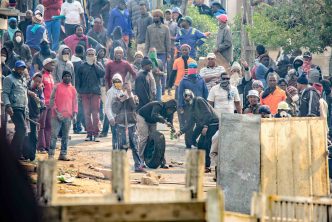Solving Nigeria’s Internal Displacement Dilemma
By Dr Oarhe Osumah
The level of displacement is an issue of great concern in Nigeria. What are the realities, consequences and possible solutions of this crisis?
The world is currently enmeshed in a displacement crisis. Over 79.5 million persons are displaced worldwide due to several factors, including violent conflicts and persecution. With 3.4 million displaced persons, Nigeria contributes 4.3 percent of the global figures, making her one of the top 10 countries with the highest risk of a humanitarian disaster in 2019. The key drivers of displacements in Nigeria include the decade-long Boko Haram insurgency, inter-communal clashes, clashes between sedentary farmers and nomadic herdsmen, armed banditry, and the seasonal overflow of rivers and water bodies. The alarming level of displacement generates concerns and commitments. The Nigerian governments, international development partners and sympathetic Nigerians have worked to address the displacement challenge. Despite these efforts, the challenges are unabated. This issue of Nextier Insights highlights the realities and consequences of the displacement crisis in the country, with particular reference to the displacement occasioned by the protracted Boko Haram insurgency in the North East, and proffers ways to solve the problem.
The Boko Haram crisis has produced one of the most significant displacement figures in modern history. The sect is responsible for the displacement of over 2.7 million people in Nigeria’s North-East region which is almost 80 percent of the total displacement figures (3.4 million) in Nigeria. The same insurgency has led to a displacement of more than 680,000 people into Cameroon, Chad, and Niger.
Life is tough for these internally displaced persons. About 40 percent of them reside in overcrowded camps and live in appalling conditions. Cases abound of poor access to basic amenities such as drinkable water, healthcare, and education in the various camps (Amina and Ibrahim, 2019). The displaced persons are vulnerable to insecurity, hunger, malnutrition, diseases, and human rights violations (Osumah, 2019). There are cases of exploitation for cheap labour, predatory and transactional sex for food, shelter and other assistance, and rape with associated incidents of unwanted pregnancies in several camps and transitional settlements. Many of the displaced persons have been deliberately targeted and subjected to violence, intimidation, and extortion by insurgents, criminal elements, camp managers, civilian militia, and unscrupulous security agents. They have suffered personal, emotional, social and material losses, including continuing insecurity, further displacement through attacks on camps and settlements, loss of livelihoods, houses, and dignity (Olarenwaju, Olarenwaju, Omotoso, Alabi, Amoo, Loromeke and Ajayi, 2019). Individuals and families are dependent on others for survival and, on account of these experiences, have become traumatised.
As a signatory to the Kampala Convention and other instruments, the Nigerian government has made various efforts to assist and protect displaced persons as well as find durable solutions to displacement. Many organisations such as presidential initiatives and committees, Inter-ministerial Taskforces, and North East Development Commission are working in tandem with the State Emergency Management Agency (SEMA) and the National Emergency Management Agency (NEMA). Also, the U.N. agencies and development partners have been assisting.
However, both the Nigerian government and international aid agencies are becoming stressed. Despite the military presence and its reassurances of return of normalcy, the region’s security situation remains mostly fluid and unpredictable. This situation has been a source of concern to aid workers assisting the displaced persons. As of 2019, the decade-long insurgency resulted in 37 humanitarian workers killed and several others kidnapped. In July 2020, there were cases of insurgents’ ambush of soldiers, attack on Borno State Governor’s convoy and death of five aid workers. This situation frustrates access to displaced persons by humanitarian workers.
Furthermore, there are visible fragmentation and non-coordination in the collective response of humanitarian organisations working in the region (Mohammed, 2017). Humanitarian funding also lags, with a 2019 United Nations Appeal only realising 43 percent of the funds needed. Meanwhile, there has been mounting allegations of corruption, misappropriation and mismanagement of funds meant to improve the quality of life of the displaced persons.
Based on the profile of displacement dilemma, there is a range of potential intervention programmes to address the challenge. The ideal solution must have the following critical elements:
- Mitigation of drivers of displacement: Key drivers of displacement are mitigated through conflict prevention and containment. Some of the approaches include (a) implementing early warning protocols especially in the high risk and fragile communities, (b) taking early and decisive actions to deescalate violent conflicts (c) ensuring sustainable peace by upholding the rule of law (d) strengthening capacities of the security apparatuses for preventive actions and prompt interventions in violent situations (e) strengthening local resilience through sensitisation programmes on how to explore their adaptive and reactive capacities in the face of security threats.
- Livelihood programmes: The displaced persons, returnees and the host population need assistance to rebuild their livelihoods capacities. These populations require assistance and empowerment to achieve self-reliance and resilience to cope with future shocks. Such programmes should include micro-finance schemes to boost income generation and small businesses, and vocational training programme to help them learn new skills and capabilities relevant to their new setting. Nigerian government agencies and humanitarian donors can learn a few lessons from how Georgia and Azerbaijan adopted this model to provide livelihood support to displaced persons. Furthermore, agricultural support activities such as de-mining of farmlands, agricultural extension services, and distribution of seeds, seedlings, chemicals, and tools are essential to help them return to farming.
- Relocation: This recommendation is essential to decongest camps, mitigate associated protection risks with overcrowded camps and improve the living conditions of the displaced persons. Relocation models are applied in various scenarios, for example, Sri Lanka’s post-tsunami resettlement programmes.
- Infrastructure revitalisation programme: It is imperative to restore essential public services in various communities. This intervention must prioritise safer housing, safer and more accessible water and sanitation facilities, healthcare services, and education. Sudan exemplifies the importance of ensuring revitalisation of infrastructure, public services, and resources in the communities of origin of the displaced persons. There is a need to build technological and financial infrastructures in Boko Haram-ravaged communities to provide and facilitate immediate humanitarian relief and support.
- Collaboration among stakeholders: Concerted coordination among governments, humanitarian and development agencies, private sector, and civil society organisations is needed to appreciate better the socio-economic challenges displaced persons face while simultaneously targeting their diverse needs. This collaboration is achievable through digital data sharing by all the stakeholders.
- Policy Framework: Nigeria needs to enact a comprehensive and integrated national policy for internally displaced people. Such a policy will guide new approaches to internal displacement, from prevention to development. Nigeria can draw lessons from the experiences of Colombia and Niger in this respect.
Conclusion
The protracted Jihadist insurgency in Nigeria has caused devastating displacement in the North East region. The proposed interventions demand the need to evolve a combination of critical measures by the Nigerian government and its partner humanitarian organisations. Elements of the solution should include addressing the drivers of the violence and improving the diverse conditions of the displaced persons and their host population. These interventions should consist of livelihood support programmes, relocation assistance, and revitalisation of infrastructures. Of paramount importance is the need to improve coordination among humanitarian partners through information sharing and enactment of an integrated national IDP policy to guide responses to the displacement dilemma.







